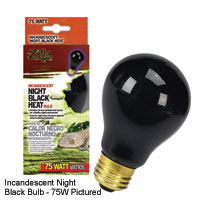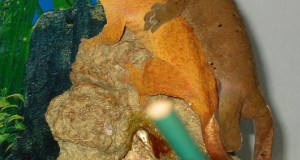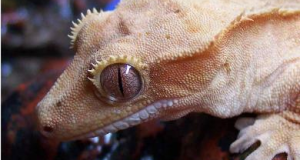When cared for properly, Leopard Geckos are among the most hardy and long-lived of all reptile pets. But apparently-healthy geckos sometimes refuse to feed, or cut back on their intake, and there is still much confusion as to why this occurs. My work with Leopard Geckos and hundreds of other species in zoos and at home has (I hope!) provided me with some useful insights into this problem. Some involve areas that any good reptile keeper would investigate – environment, stress levels, disease – while others, such as the effects of circadian rhythms (“internal clocks”), are less obvious.
Winter’s Arrival and Internal Rhythms Regulate Eating
Leopard Geckos are native to southeastern Afghanistan, western India, Pakistan, Iraq, and Iran, where they inhabit desert fringes and arid grasslands. In some parts of this range, temperatures rise to 100+ F in summer and drop below 32 F during the winter. Wild Leopard Geckos living in environments that experience severe winters become dormant for several months each year, while those in milder regions may remain active (please see the article linked below to read more about their natural history).
While your pet is, no doubt, many generations removed from the wild, internal circadian rhythms may cause it to become lethargic and refuse food during the winter. This can happen even if your gecko is kept warm and given a photo-period of 12-14 hours. To confuse matters further, some reptiles enter dormancy when winter arrives in their native habitats…even if it happens to be summertime in their present home! I’ve seen this among Indian Gharials (fish-eating crocodiles) 15 years removed from the wild, and in many others. Captive Bearded Dragons also exhibit this type of behavior on occasion; please see this article.
 Unfortunately, it’s not often possible to be certain that a pet has stopped feeding due to the effects of an internal rhythm, so be sure to check the other possibilities discussed below.
Unfortunately, it’s not often possible to be certain that a pet has stopped feeding due to the effects of an internal rhythm, so be sure to check the other possibilities discussed below.
Next I’ll mention other things that should be checked if your gecko stops feeding, including husbandry (tank set-up, temperatures, diet, etc.), stress, and disease. I’ve written on each of these in further detail in the linked articles.
Your Gecko’s Environment
As Leopard Geckos are nocturnal, it’s important to monitor nighttime temperatures, especially during the winter, when most people lower their home thermostats. The ambient air temperature should range from 78-84 F, which can be maintained by a ceramic heater or red/black reptile “night bulb”; a below-tank heat mat should be positioned so that one corner of the tank is warmer (88 F) than the rest. Be sure also to establish a thermal gradient (areas of different temperatures) so that your gecko can regulate its body temperature as needed.
 While Leopard Geckos often adapt to smaller enclosures than do other lizards, individuals vary in their response to crowding. Moving your pet to a larger terrarium may help, and this will also make it easier for you to establish a thermal gradient (small terrariums tend to remain at the temperature of the basking site).
While Leopard Geckos often adapt to smaller enclosures than do other lizards, individuals vary in their response to crowding. Moving your pet to a larger terrarium may help, and this will also make it easier for you to establish a thermal gradient (small terrariums tend to remain at the temperature of the basking site).
And, no matter how well-adjusted or bold your pet may be, it’s important to provide a dark, secure cave or other shelter. Geckos forced to remain exposed often cease feeding.
Diet
Wild Leopard Geckos feed upon a huge array of invertebrates, while pets are often limited to 2-3 food items. Dietary variety is important for health reasons. But providing different types of insects can also incite new interest in feeding. We see this most commonly in chameleons, but the enthusiasm your Leopard Geckos will show for novel foods will leave you with no doubt as to their value. Please see this article to read more about adding silkworms, house flies, sow bugs, wild-caught insects and other important foods to your pet’s diet.
Stress Can Affect Eating
Geckos may be stressed by the mere presence of a dominant cage-mate, even absent fighting. If you suspect aggression, observe your geckos after dark, when they will be most active (a red/black reptile bulb will prove useful). Appetite-suppressing aggression is especially common among young geckos that are being raised in groups.
Locating the terrarium in a noisy part of the house, or where there are vibrations from machinery, may also depress appetites and contribute to other health concerns.
Disease and other Health Issues
Impactions from substrate swallowed with meals and Metabolic Bone Disease are two of the more common reasons that geckos cease feeding.
Other health concerns that have been identified include Hyperthyroidism, Eyelid Lining Retention (following shedding) and Cryptosporidiosis. Internal or external parasites, and a host of other less common ailments, should also be investigated if your pet stops eating. Please post below if you need help in locating a reptile experienced veterinarian.
Further Reading
The Ideal Leopard Gecko Terrarium
 That Reptile Blog – Reptile, Amphibian and Exotic Pet Care and Information
That Reptile Blog – Reptile, Amphibian and Exotic Pet Care and Information





Hi I’m getting a new leopard gecko but I’m not sure if I’m ready to have them breeding yet, because I don’t know if my local pet store would buy them off of me. I took my gecko to the pet store to find out the sex of the gecko but she was unsure but said it might be a female. Later this month I’m going to a reptile expo to purchase another leo and to find out the sex of my gecko. I need someone’s opinion on if I should buy another female if my gecko is a female. If it turns out that I have 1 male then I need to get 1 female because you can have 2 males in the same tank. What should I do with the babies?
Hello Dakota,
Females usually get along but must be watched closely; plan on a 20 gallon long style tank or larger, and add plenty of driftwood, caves etc so that they can stay apart if need be. Young are not easy to sell, as there are so many mass breeders; local pet stores may take them, but don’t plan on supplementing your income with gecko breeding! Best, Frank
My cage is only at 72° in the day time should I get a bigger lightbulb?
Thanks.
hello,
Yes, Pleases see the suggested temperatures and the bulbs or sub-tank heater (links in the article) and let me know if you need further info. best, Frank
My son recently got a junvinile leopard gecko. The pet smart we bought it from said they put about 10 crickets a day in the morning for the geckos diet. Yesterday my son placed 7 crickets in the cage. This am has be 24 hours and the gecko hasn’t ate anything. I can still count 7 crickets. What can I do to get it to eat? I know it’s stressed from the move from the pets tore to our home. Is this normal? The cage stays anywhere from 70-80° (pet store said 65-80) was ideal. I have always had dogs so this gecko os new to me. Please help! We haven’t tried meal worms or anything yet bc the pet store said they only fed it crickets.
It is very likely due to the stress of the move, and that he simply isn’t hungry. Typically, we would recommend to customers to wait to feed new reptiles up to two days. If the Petsmart employee stated that they feed them 10 crickets in the morning then the gecko you purchased has already eaten for the day. He may eat today, but he might not eat anything until tomorrow. I would suggest putting the crickets back into the cricket keeper for the time being, and try feeding him again tomorrow. Be sure that he does have fresh water though.
Try waxworks in a small dish, they can’t escape, much tastier, smaller and easier to digest, plus u don’t gotta listen to crickets, obviously they need a variety of food but wax worms is one of the best things you can feed the juveniles in my opinion, mine all went nuts for them. Put the dish full of them under heat lamp for just a few seconds at a time and I’ll start wiggling like crazy but if you leave them under it for a few seconds too long though I’ll die very quickly so just until they wake up and I put the dish in front of the gecko so that you can see them we’re going because they’ll stop fairly quickly once they cool down a little bit , being that he’s in a new surrounding area this might make him more comfortable and it will be easier for you in part because you can tell what’s been in the dish you’re not in the dish but also keep in mind the crickets will slowly eat the worms as well but that’s not a bad thing because when he needs the crickets crickets are now gut filled with
Wax worms. I even still feed them to my very large bearded dragons and I fed them to my largest geckos when I had my geckos because they really liked him more than any other insect really, they just aren’t big enough to be the main diet for a larger animal nor should they be because just like any other critter they need some variety
So I have a young unsexed leopard gecko, purchased at a pet store. The first couple of months went fine, now he has completely stopped eating and grown very skinny. I have experience with other reptiles, but this is my first gecko. It’s actually my son’s.
He looks okay, other than being very thin, good coloration, no visible issues.
He’s still very small, and is currently in a 10 gallon. . I’m only using a uth now as it’s gotten warm. Temps stay high, he’s on carpet, so no risk of impaction.
My son did accidentally shut off the extension cord for a while, around when this began. And it was getting cold at night at the time. So probably a few days with no heat. I’m wondering if that triggered it.
I’m trying to feed him mashed crickets, Turkey baby food, calcium, and repti vitamin soup. Lol I can only get him to eat so much. I’m hoping once he gets his strength back he’ll begin to eat on his own again?
Any suggestions?
He also has two hides, one humid, the other dry. I will also mention, I have yet to see it shed. Not sure how quickly that comes on with geckos, but if it’s similar to snakes, when they are in “blue” it hasn’t happened. But it’s skin does look healthy and bright.
Any ideas are appreciated. As I said, he is very thin, and deteriorating. I have yet to find a reptile vet, And I don’t want to even waste the money on your run of the mill dog and cat vet.
I purchased a bearded dragon on Friday gave her a couple hours then tried feeding her to no avail. So far I’ve tried feeding her crickets daily and have put fresh fruit and veggies in her tank. Her basking area stays around 100 deg and her cool side is 75 ish, it is now Sunday night and she still will not/has not eaten. I have a uvb light on from 8-9 am till 10 pm and use a red basking light that stays on 24/7. Is there a problem I’m not seeing am I doing something wrong is she just stressed from the move? Please help…
I wouldn’t worry much about it if it hasn’t been too long because in all honesty, most reptiles including these little guys whom I have had many of, can go a very long time without food and even water but to a lesser degree, if it’s still drinking water and I wouldn’t worry much about it all if it’s not doing either but I’ll be a little bit more concerned but I wouldn’t get too worried too soon. Just allow them to adjust to the new atmosphere and make sure the tank conditions are the same as they were before or as close to it as possible remember with them you want dry heat But just Google any fact sheet and just follow it to the tee. Also wax worms are good when they are eating because one they tend to like them to they’re very easy for them to digest and have a lot of nutrients plus they’re also pretty darn small so I would give them some of those, if you put a little dish of them under the heat lamp for just a few seconds at a time the wax worms hate the heat so they’ll start wiggling like crazy and then put the dish in front of them so he can see it I don’t put the worms under light for too long just long enough to make him start wiggling because it will kill them very very quickly sense when storing them you generally keep them stored at about 45°.
My oldest one that I had for a very long time stop eating on me and no matter what I tried it just weather away and die on me so my assumption is that it just got very sick but it did take a very long time too, I even came close to putting her out of her misery at one point but she never acted all that miserable until the very end she just wasn’t eating, but she was old and you definitely caught something so I don’t think that’s your problem here it is something to be cognizant of. There’s also a lot of little things you can do try to make the set up as close as you can to the set up as you had before just to make it comfortable and then start changing it piece by piece so that the animal doesn’t get too freaked out. Also make sure that all the poop is cleaned up because sometimes delete it and sometimes it can be pretty bad for them, when I comes to bearded dragons which I have a few of, their excrement is just like toxic so I do my best to always stay on top of that and the two that I have right now are by far the healthiest ones I’ve ever had and I’ve lived the longest by far and they’re getting pretty huge. I have no geckos left but the ones that I did have lived good long lives.
Great article. I have also found that simply offering food at a different time of day can get a gecko feeding. I usually feed my geckos in the evening, but with trouble feeders I will sometimes try early in the morning with good results.